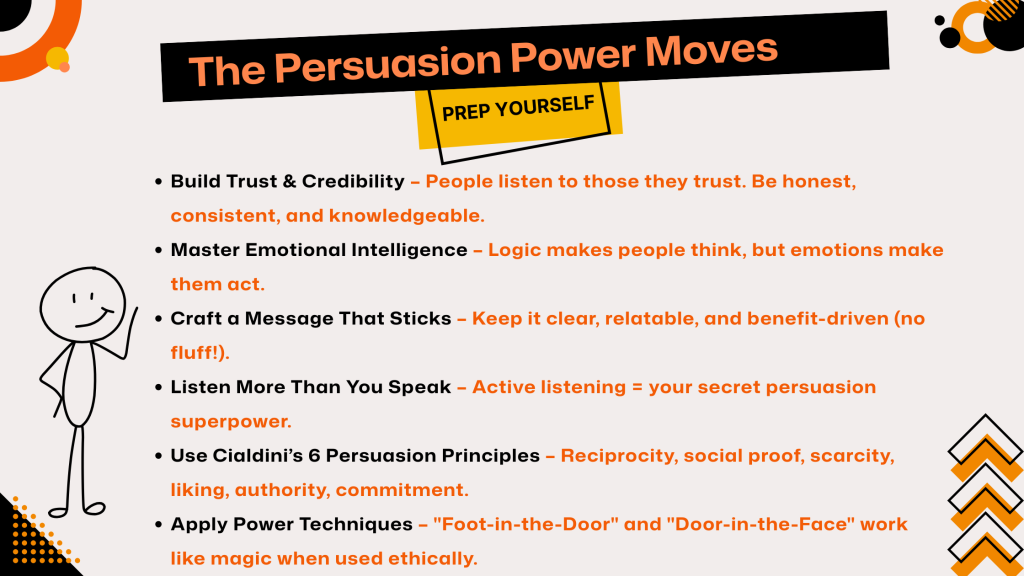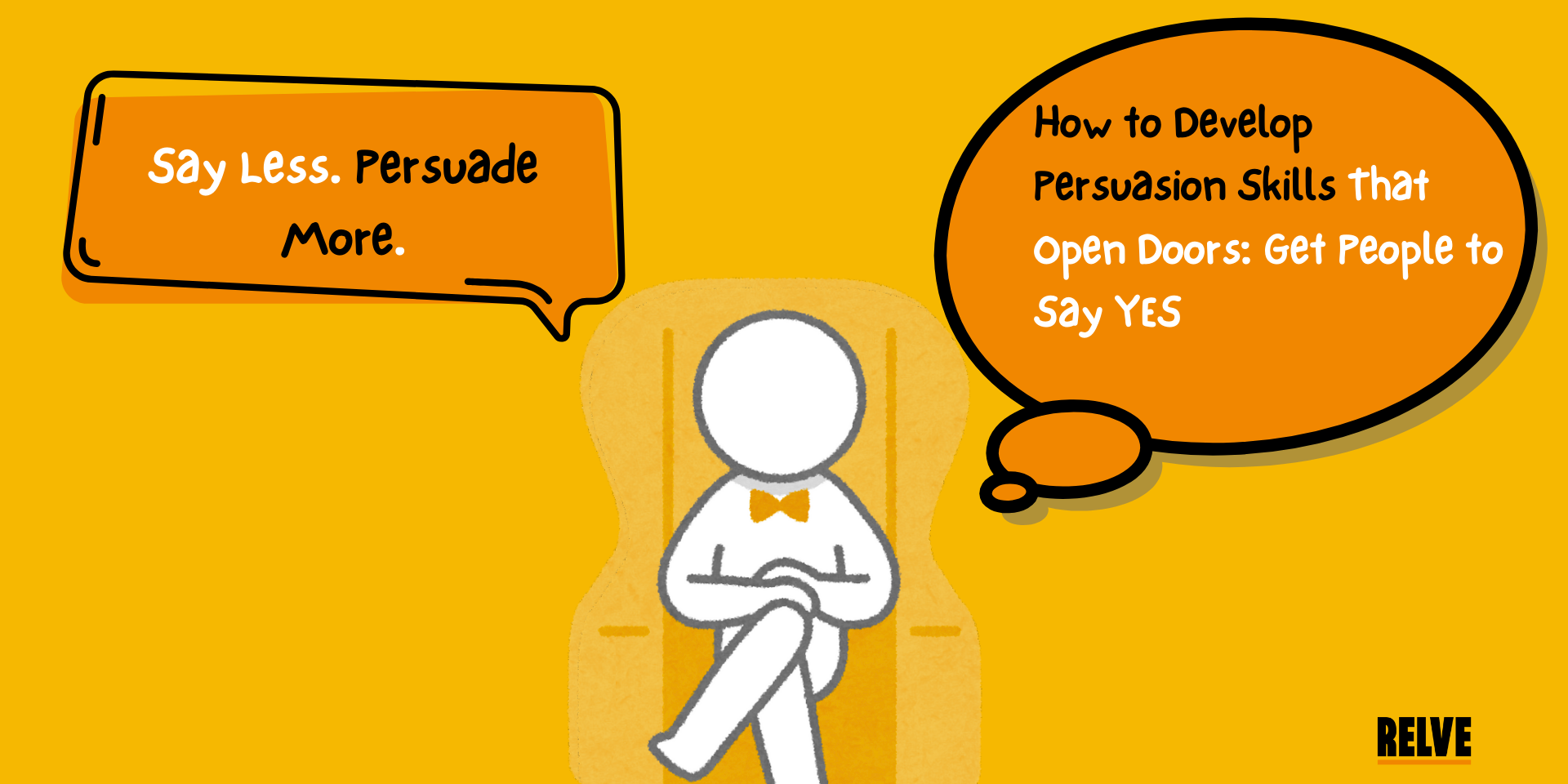How to Develop Persuasion Skills and Get What You Want Without Manipulation
You’re at a coffee shop, trying to convince your friend to watch your favourite movie instead of theirs. They hesitate. You bring out a solid argument, maybe even throw in a “Trust me, you’re going to love it.” Suddenly, they nod. Victory.
Now, imagine taking that same persuasive magic and using it to land a dream job, negotiate a better salary, or even inspire people to take action on a cause you care about.
That’s the power of persuasion. But here’s the secret—persuasion isn’t about trickery or smooth-talking. It’s about understanding human psychology, building trust, and crafting compelling messages that make people naturally want to say YES.
So, if you’ve ever wondered how to develop persuasion skills that actually work—without coming across as pushy or manipulative—you’re in the right place. Let’s break it down step by step.
1. The Psychology Behind Persuasion

Before you master how to develop persuasion skills, you need to understand what makes people say “YES” in the first place.
In deciding whether to say yes or no to a requester, it is clear that we frequently pay attention to but one piece of the relevant information in the situation.
Dr. Robert Cialdini, Influence
Translation? People don’t always think rationally when making decisions. Emotions, biases, and subconscious cues play a massive role. This is why ads featuring adorable puppies (aww 🐶) or powerful storytelling make us feel something—and that feeling influences our choices.
So, what actually persuades someone? The three main triggers are:
- Emotional Connection – People buy feelings, not just products. (Ever cried over a Google Reunion ad? Yeah, emotions win.)
- Cognitive Biases – Our brains are wired for shortcuts. (Example: We trust doctors in white coats more, even if they’re actors!)
- Social Influence – We follow the crowd. (Ever picked a restaurant just because it had a longer line? Same.)
2. The Core Pillars of Persuasion

Mastering how to develop persuasion skills isn’t just about talking well—it’s about combining trust, emotion, and logic.
Persuasion is not about how bright or smooth or forceful you are. It’s about the other party convincing themselves that the solution you want is their own idea. So don’t beat them with logic or brute force. Ask them questions that open paths to your goals. It’s not about you.
Chris Voss, Never Split the Difference
Here’s what makes persuasion work:
- Credibility – People follow leaders they trust. (Would you take financial advice from a random guy at the bus stop? Probably not.)
- Emotional Connection – Logic makes people think, but emotions make them act.
- Logical Reasoning – Even if emotions hook people in, they still need facts to justify their decision.
3. How to Develop Persuasion Skills: By Building and Maintaining Credibility
Imagine you’re pitching an idea to your team, but no one takes you seriously. The problem? You might not have built credibility yet.
All things being equal, people will do business with, and refer business to, those people they know, like, and trust.
Bob Burg, The Art of Persuasion
To develop persuasive skills, first, make sure people believe you. Here’s how:
- Be Consistent – Your actions should match your words. (Don’t be that person who preaches healthy eating while downing a whole pizza).
- Become an Expert – People trust knowledge. Read, learn, and share valuable insights.
- Show Authenticity – Be real, own your flaws, and be transparent.
4. How to Develop Persuasion Skills with Emotional Intelligence
Persuasion isn’t just about what you say—it’s about how they feel.
When faced with a difficult question, we often answer an easier one instead, usually without noticing the substitution.
Daniel Kahneman, Thinking, Fast and Slow
To develop persuasion skills, you must understand emotions—both yours and others. Here’s how:
- Empathy is Everything – The best persuaders put themselves in others’ shoes. (Would you be convinced by your own argument?)
- Read the Room – If someone looks uninterested, adjust your approach. (Talking at someone vs. talking with them.)
- Use Storytelling – Facts inform, but stories inspire. (Ever noticed TED Talks start with personal stories? It’s intentional.)
5. Crafting a Persuasive Message That Works Every Time
You ever hear someone explain something so poorly that you end up less convinced than before? Yeah, we’ve all been there.
A persuasive message isn’t just about throwing facts at people—it’s about packaging your message in a way that makes people want to listen.
A few vivid details might be more persuasive than a barrage of statistics.
Chip Heath & Dan Heath, Made to Stick
Here’s the formula for crafting a message that actually works:
- Clarity is Key – No jargon, no fluff, no confusing words. Keep it crisp. (Think: Would a 12-year-old understand this?)
- Make it About Them – People care about how it benefits them, not just why it matters to you.
- Use Social Proof – “Look! Others did this and succeeded!” (Testimonials, case studies, and stats work wonders.)
- Call to Action (CTA) – Guide them toward what you want them to do next. (Don’t assume they’ll just “figure it out.”)
6. Active Listening: The Hidden Superpower of Persuasion
Persuasion isn’t just about talking. The best persuaders? They LISTEN.
Here’s how to level up your active listening skills and develop persuasion skills at the same time:
- Shut Up & Listen – Don’t think about what you want to say next—truly hear what the other person is saying.
- Mirror & Reflect – Repeat the last few words of their sentence to show understanding. (Ex: “So you’re saying you want more flexibility at work?”)
- Ask Thoughtful Questions – Instead of pushing your agenda, ask why they think the way they do.
7. How to Develop Persuasion Skills Using Body Language
Ever talked to someone who said all the right things—but their body language screamed NOPE?
Your words are only half the story—the rest is non-verbal communication.
Here’s how to use body language to develop persuasive skills:
- Eye Contact – Avoiding eye contact? You seem shady. Staring too hard? You seem intense. Balance is the key.
- Open Gestures – Hands out = approachable. Arms crossed = defensive.
- Facial Expressions – Match your emotions to your words. (Nothing’s worse than someone saying “I’m excited” with a blank face.)
- Power Posing – Standing confidently (feet shoulder-width apart, upright posture) actually makes you feel more persuasive.
8. The 6 Universal Principles of Persuasion (From Robert Cialdini)
Dr. Robert Cialdini, the grandmaster of persuasion, identified six principles that make people say YES.
Let’s break them down:
- Reciprocity – When people receive something, they feel obligated to give back. (Ex: Free samples make people buy more!)
- Commitment & Consistency – People stick to what they’ve previously agreed to. (Ex: Signing up for a free newsletter makes people more likely to buy later.)
- Social Proof – If others are doing it, we assume it’s the right thing to do. (Ex: “Bestseller” labels drive more sales!)
- Authority – People trust experts. (Ex: Lab coats = “This doctor must be smart.”)
- Liking – We say yes to people we like. (Ex: Ever bought something just because the salesperson was super nice?)
- Scarcity – When something’s limited, we want it more. (Ex: “Only 2 seats left at this price!”)
9. How to Develop Persuasion Skills Using Ethically
Persuasion ≠ Manipulation.
Manipulation is selfish and deceitful. Ethical persuasion is about creating win-win situations.
If, in the process of persuading a person to your side of an issue, they feel as good about it as you do, then you have not bullied, coerced or manipulated.
Bob Burg, The Art of Persuasion
✅ DO use persuasion to create positive outcomes.
❌ DON’T trick people into saying YES when it’s not in their best interest.
10. How to Develop Persuasion Skills Using “Foot-in-the-Door” and “Door-in-the-Face” Techniques
Ever been tricked into saying “YES” to something you weren’t planning to? Congrats—you’ve been hit with classic persuasion techniques.
Foot-in-the-Door Technique
- How it works: Start with a tiny request → Once they say yes, hit them with a bigger one.
- Example: You ask a coworker, “Can you review this one paragraph?” Later, you follow up with “Hey, can you proofread my whole report?”
- Why it works: Humans love consistency—once they’ve said yes to something small, they feel compelled to continue.
Door-in-the-Face Technique
- How it works: Ask for something huge (knowing they’ll say no) → Then follow up with a smaller, more reasonable request.
- Example: “Can I borrow $500?” → “Okay, what about just $50?”
- Why it works: The contrast makes the second request seem way more reasonable than it originally would have.
11. How to Develop Persuasion Skills in Everyday Life
You already use persuasion every day—you just don’t realize it!
- At Work: Convincing your boss to let you work remotely? Persuasion.
- In Sales & Business: Closing deals without sounding pushy? Persuasion.
- In Relationships: Getting your partner to choose your restaurant? Persuasion.
- With Kids: Making them eat veggies? Persuasion. (Hardest level, tbh.)
Conclusion
By now, you’ve got the blueprint for how to develop persuasion skills that can open doors, create opportunities, and help you navigate life like a pro. But remember—persuasion isn’t about tricking people. It’s about understanding what matters to them and finding common ground.
Recap the Persuasion Power Moves:

So, here’s your challenge:
Go out and use one persuasive technique today—whether it’s convincing a friend to watch your Netflix pick, negotiating a better deal, or just getting someone to agree with you in a debate.
